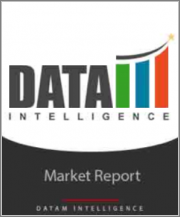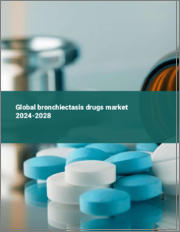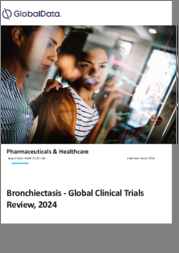
|
시장보고서
상품코드
1373371
세계의 기관지 확장증 치료제 시장(2023-2030년)Global Bronchiectasis Drugs Market - 2023-2030 |
||||||
개요
기관지 확장증은 염증과 감염으로 인해 기관지 벽이 두꺼워지는 만성 질환입니다. 기관지 확장증 환자는 주기적으로 호흡곤란이 재발하는 악화를 반복합니다.
기관지 확장증의 증상으로는 호흡곤란을 동반한 만성 기침, 구토, 흉통 등이 있습니다. 기관지 확장증은 증식이나 비암성 종양과 같은 기도폐쇄도 원인이 될 수 있습니다. 기관지 확장증 치료에 사용되는 일반적인 약물에는 항생제, 거담제, 점액 용해제 등이 있습니다.
시장 역학
기관지 확장증 유병률 증가
기관지 확장증의 유병률 증가는 시장 성장의 중요한 촉진요인입니다. 기관지 확장증은 종종 만성 폐쇄성 폐 질환이 있는 경우 발생하며, 지속적인 기관지 확장 및 심한 기관지염증으로 병리학적으로 특징지어집니다.
예를 들어, 2022년 국립보건원 보고서에 따르면 중국 성인의 기관지 확장증 유병률은 10만 명당 75.48명(62.26명, 88.69명)에서 174.45명(137.02명, 211.88명)으로 2.31배 증가했다고 합니다.
또한, 2022년 12월에 발표된 호주왕립종합진료의학회(Royal Australian College of General Practitioners) 보고서에 따르면, 호주 중부의 소아 기관지 확장증 추정 유병률은 10만 명당 1470명이라고 합니다.
또한, 폐 질환 발병률 증가, 노령 인구 증가, 임상시험 증가와 같은 중요한 성장 요인이 예측 기간 동안 시장을 견인할 것으로 예상됩니다.
승인된 약품 부족
기관지 확장증 치료제의 미승인, 엄격한 규제 정책, 높은 연구개발비용, 기관지 확장증 진단 미흡, 대체 치료법 선호 등이 예측 기간 동안 기관지 확장증 치료 시장의 성장을 저해하는 요인으로 작용할 것으로 보입니다.
목차
제1장 조사 방법과 조사 범위
제2장 정의와 개요
제3장 주요 요약
제4장 시장 역학
- 영향요인
- 성장 촉진요인
- 성장 억제요인
- 기회
- 영향 분석
제5장 산업 분석
- Porter의 Five Forces 분석
- 공급망 분석
- 가격 분석
- 규제 분석
- DMI의 견해
제6장 COVID-19 분석
제7장 질환 유형별
- CF기관지 확장증
- 비CF기관지 확장증
제8장 약제 유형별
- 항생제
- Erythromycin
- Clarithromycin
- Roxithromycin
- Azithromycin
- Amoxicillin
- 기타
- 거담제
- Hypertonic Saline
- Inhaled Mannitol
- 기타
- 점액 용해제
- Bromhexine
- N-Acetylcysteine
- Erdosteine
- Fudosteine
- 기타
- 기타
제9장 투여 경로별
- 경구
- 비경구
- 흡입
제10장 유통 채널별
- 소매 약국
- 병원 약국
- 온라인 약국
제11장 지역별
- 북미
- 미국
- 캐나다
- 멕시코
- 유럽
- 독일
- 영국
- 프랑스
- 이탈리아
- 스페인
- 기타 유럽
- 남미
- 브라질
- 아르헨티나
- 기타 남미
- 아시아태평양
- 중국
- 인도
- 일본
- 호주
- 기타 아시아태평양
- 중동 및 아프리카
제12장 경쟁 구도
- 경쟁 시나리오
- 시장 현황/점유율 분석
- M&A분석
제13장 기업 개요
- Zambon S.p.A.
- 기업 개요
- 제품 포트폴리오와 설명
- 재무 개요
- 주요 발전
- Pfizer Inc.
- Merck KGaA
- Soigner Pharma Pvt Ltd
- Teva Pharmaceuticals
- LGM Pharma LLC
- Texas Pharmaceuticals Pvt. Ltd.
- Orion Life Science
- Cepham Life Sciences Inc.
- AdvaCare Pharma
제14장 부록
LSH 23.11.10Overview
Bronchiectasis is a chronic condition where the walls of the bronchi are thickened from inflammation and infection. Individuals with bronchiectasis have periodic flare-ups of breathing difficulties called exacerbations.
Symptoms of bronchiectasis include chronic cough with shortness of breath, coughing up blood, and chest pain. The airway blockage like a growth or a noncancerous tumor can also lead to bronchiectasis. Common drugs used in the treatment of bronchiectasis include antibiotics, expectorants, and mucolytics
Market Dynamics
Increasing prevalence of bronchiectasis
The increasing prevalence of bronchiectasis acts as a significant driver for market growth. Bronchiectasis often occurs in the presence of chronic obstructive pulmonary disease and is characterized pathologically by permanent bronchial dilatation and severe bronchial inflammation.
For instance, according to a National Institute of Health report published in 2022, Chinese adults had a 2.31-fold increase in the prevalence of bronchiectasis, going from 75.48 (62.26, 88.69) per 100,000 to 174.45 (137.02, 211.88) per 100,000.
Additionally, according to the Royal Australian College of General Practitioners report published in December 2022, states that the estimated prevalence of bronchiectasis is 1470 per 100,000 in Central Australian children.
Furthermore, significant growth drivers such as the rising incidence of pulmonary diseases, the growing geriatric population, and increasing clinical trials, are expected to drive the market in the forecast period.
The lack of approved drugs
The lack of approved drugs for bronchiectasis, stringent regulatory policies, high costs involved in research and development under-diagnosis of bronchiectasis, and preference for substitute treatment options are some factors hampering the growth of the bronchiectasis treatment market over the forecast period.
Segment Analysis
The global bronchiectasis drugs market is segmented based on disease type, drug type, route of administration, distribution channel, and region.
The antibiotics segment accounted for approximately 52.2% of the market share
Antibiotics are expected to hold the largest market share over the period forecast owing to increasing clinical trials conducted for bronchiectasis with antibiotics. A total of 314 clinical trials were performed till 2023 for the treatment of bronchiectasis with antibiotics.
For instance, according to clinicalTrials.gov, on September 7, 2023, Belfast Health and Social Care Trust in collaboration with Queen's University started a clinical trial of Hypertonic Saline and Carbocisteine in Bronchiectasis. It is currently in phase 3 and the estimated study completion date is September 2024.
Additionally, on September 21, 2023, Insmed Incorporated conducted a clinical trial on the efficacy, safety, and tolerability of Brensocatib in participants with non-cystic fibrosis bronchiectasis. It is currently in phase 3 and the estimated study completion date is March 2024.
Geographical Analysis
North America is expected to hold a significant position in the global bronchiectasis drugs market share
The global bronchiectasis drugs market is segmented into North America, Europe, Asia Pacific, South America, Middle East, and Africa.
North America has maintained a significant market proportion due to factors such as the rising prevalence of bronchiectasis infections and drug approvals, this trend is anticipated to continue throughout the forecast period.
For instance, according to the American Lung Association report published in 2022, The risk of developing bronchiectasis increases with age, and Bronchiectasis affects 350,000 to 500,000 people in the United States. The incidence of bronchiectasis is more common in women than in men.
Additionally, in April 2022, Zambon received a U.S FDA Breakthrough Therapy Designation for colistimethate sodium powder for nebulization solution for the reduction in the incidence of pulmonary exacerbations in adult patients with non-cystic fibrosis bronchiectasis (NCFB).
COVID-19 Impact Analysis:
The COVID-19 pandemic has had a significant impact on the global bronchiectasis drugs market. The pandemic disrupted the conduct of clinical trials, with many sites temporarily halting enrollment or modifying protocols to prioritize patient safety. This has led to delays in the completion of trials and the availability of new treatment drugs. Therefore, the bronchiectasis drugs market is expected to be moderately affected over the forecast period.
Competitive Landscape
The major global players in the market include: Zambon S.p.A., Pfizer Inc., Merck KGaA, Soigner Pharma Pvt Ltd, Teva Pharmaceuticals, LGM Pharma LLC, Texas Pharmaceuticals Pvt. Ltd., Orion Life Science, Cepham Life Sciences Inc., AdvaCare Pharma among others.
Key Developments
- In September 2023, Inogen Inc. acquired Physio-Assist SAS. A technology-enabled airway clearance and mucus management device, Simeox from Physio-Assist, is primarily used to treat bronchiectasis.
- In December 2022, Life science charity LifeArc partnered with the European Multicentre Bronchiectasis Audit and Research Collaboration (EMBARC) to tackle the respiratory disease bronchiectasis.
Why Purchase the Report?
- To visualize the global bronchiectasis drugs market segmentation based on disease type, drug type, route of administration, distribution channel and region as well as understand key commercial assets and players.
- Identify commercial opportunities by analyzing trends and co-development.
- Excel data sheet with numerous data points of global bronchiectasis drugs market-level with all segments.
- PDF report consists of a comprehensive analysis after exhaustive qualitative interviews and an in-depth study.
- Product mapping available as Excel consisting of key products of all the major players.
The global bronchiectasis drugs market report would provide approximately 69 tables, 67 figures, and 185 Pages.
Target Audience 2023
- Manufacturers/ Buyers
- Industry Investors/Investment Bankers
- Research Professionals
- Emerging Companies
Table of Contents
1. Methodology and Scope
- 1.1. Research Methodology
- 1.2. Research Objective and Scope of the Report
2. Definition and Overview
3. Executive Summary
- 3.1. Snippet by Disease Type
- 3.2. Snippet by Drug Type
- 3.3. Snippet by Route of Administration
- 3.4. Snippet by Distribution Channel
- 3.5. Snippet by Region
4. Market Dynamics
- 4.1. Impacting Factors
- 4.1.1. Drivers
- 4.1.1.1. Increasing prevalence of bronchiectasis
- 4.1.1.2.
- 4.1.2. Restraints
- 4.1.2.1. The lack of approved drugs
- 4.1.2.2.
- 4.1.3. Opportunity
- 4.1.4. Impact Analysis
- 4.1.1. Drivers
5. Industry Analysis
- 5.1. Porter's Five Force Analysis
- 5.2. Supply Chain Analysis
- 5.3. Pricing Analysis
- 5.4. Regulatory Analysis
- 5.5. DMI Opinion
6. COVID-19 Analysis
- 6.1. Analysis of COVID-19
- 6.1.1. Scenario Before COVID
- 6.1.2. Scenario During COVID
- 6.1.3. Scenario Post COVID
- 6.2. Pricing Dynamics Amid COVID-19
- 6.3. Demand-Supply Spectrum
- 6.4. Government Initiatives Related to the Market During Pandemic
- 6.5. Manufacturers Strategic Initiatives
- 6.6. Conclusion
7. By Disease Type
- 7.1. Introduction
- 7.1.1. Market Size Analysis and Y-o-Y Growth Analysis (%), By Disease Type
- 7.1.2. Market Attractiveness Index, By Disease Type
- 7.2. CF Bronchiectasis*
- 7.2.1. Introduction
- 7.2.2. Market Size Analysis and Y-o-Y Growth Analysis (%)
- 7.3. Non-CF Bronchiectasis
8. By Drug Type
- 8.1. Introduction
- 8.1.1. Market Size Analysis and Y-o-Y Growth Analysis (%), By Drug Type
- 8.1.2. Market Attractiveness Index, By Drug Type
- 8.2. Antibiotics*
- 8.2.1. Introduction
- 8.2.2. Market Size Analysis and Y-o-Y Growth Analysis (%)
- 8.2.3. Erythromycin
- 8.2.4. Clarithromycin
- 8.2.5. Roxithromycin
- 8.2.6. Azithromycin
- 8.2.7. Amoxicillin
- 8.2.8. Others
- 8.3. Expectorants
- 8.3.1. Hypertonic Saline
- 8.3.2. Inhaled Mannitol
- 8.3.3. Others
- 8.4. Mucolytics
- 8.4.1. Bromhexine
- 8.4.2. N-Acetylcysteine
- 8.4.3. Erdosteine
- 8.4.4. Fudosteine
- 8.4.5. Others
- 8.5. Others
9. By Route of Administration
- 9.1. Introduction
- 9.1.1. Market Size Analysis and Y-o-Y Growth Analysis (%), By Route of Administration
- 9.1.2. Market Attractiveness Index, By Route of Administration
- 9.2. Oral*
- 9.2.1. Introduction
- 9.2.2. Market Size Analysis and Y-o-Y Growth Analysis (%)
- 9.3. Parenteral
- 9.4. Inhalation
10. By Distribution Channel
- 10.1. Introduction
- 10.1.1. Market Size Analysis and Y-o-Y Growth Analysis (%), By Distribution Channel
- 10.1.2. Market Attractiveness Index, By Distribution Channel
- 10.2. Retail Pharmacies*
- 10.2.1. Introduction
- 10.2.2. Market Size Analysis and Y-o-Y Growth Analysis (%)
- 10.3. Hospital Pharmacies
- 10.4. Online Pharmacies
11. By Region
- 11.1. Introduction
- 11.1.1. Market Size Analysis and Y-o-Y Growth Analysis (%), By Region
- 11.1.2. Market Attractiveness Index, By Region
- 11.2. North America
- 11.2.1. Introduction
- 11.2.2. Key Region-Specific Dynamics
- 11.2.3. Market Size Analysis and Y-o-Y Growth Analysis (%), By Disease Type
- 11.2.4. Market Size Analysis and Y-o-Y Growth Analysis (%), By Drug Type
- 11.2.5. Market Size Analysis and Y-o-Y Growth Analysis (%), By Route of Administration
- 11.2.6. Market Size Analysis and Y-o-Y Growth Analysis (%), By Distribution Channel
- 11.2.7. Market Size Analysis and Y-o-Y Growth Analysis (%), By Country
- 11.2.7.1. U.S.
- 11.2.7.2. Canada
- 11.2.7.3. Mexico
- 11.3. Europe
- 11.3.1. Introduction
- 11.3.2. Key Region-Specific Dynamics
- 11.3.3. Market Size Analysis and Y-o-Y Growth Analysis (%), By Disease Type
- 11.3.4. Market Size Analysis and Y-o-Y Growth Analysis (%), By Drug Type
- 11.3.5. Market Size Analysis and Y-o-Y Growth Analysis (%), By Route of Administration
- 11.3.6. Market Size Analysis and Y-o-Y Growth Analysis (%), By Distribution Channel
- 11.3.7. Market Size Analysis and Y-o-Y Growth Analysis (%), By Country
- 11.3.7.1. Germany
- 11.3.7.2. UK
- 11.3.7.3. France
- 11.3.7.4. Italy
- 11.3.7.5. Spain
- 11.3.7.6. Rest of Europe
- 11.4. South America
- 11.4.1. Introduction
- 11.4.2. Key Region-Specific Dynamics
- 11.4.3. Market Size Analysis and Y-o-Y Growth Analysis (%), By Disease Type
- 11.4.4. Market Size Analysis and Y-o-Y Growth Analysis (%), By Drug Type
- 11.4.5. Market Size Analysis and Y-o-Y Growth Analysis (%), By Route of Administration
- 11.4.6. Market Size Analysis and Y-o-Y Growth Analysis (%), By Distribution Channel
- 11.4.7. Market Size Analysis and Y-o-Y Growth Analysis (%), By Country
- 11.4.7.1. Brazil
- 11.4.7.2. Argentina
- 11.4.7.3. Rest of South America
- 11.5. Asia-Pacific
- 11.5.1. Introduction
- 11.5.2. Key Region-Specific Dynamics
- 11.5.3. Market Size Analysis and Y-o-Y Growth Analysis (%), By Disease Type
- 11.5.4. Market Size Analysis and Y-o-Y Growth Analysis (%), By Drug Type
- 11.5.5. Market Size Analysis and Y-o-Y Growth Analysis (%), By Route of Administration
- 11.5.6. Market Size Analysis and Y-o-Y Growth Analysis (%), By Distribution Channel
- 11.5.7. Market Size Analysis and Y-o-Y Growth Analysis (%), By Country
- 11.5.7.1. China
- 11.5.7.2. India
- 11.5.7.3. Japan
- 11.5.7.4. Australia
- 11.5.7.5. Rest of Asia-Pacific
- 11.6. Middle East and Africa
- 11.6.1. Introduction
- 11.6.2. Key Region-Specific Dynamics
- 11.6.3. Market Size Analysis and Y-o-Y Growth Analysis (%), By Disease Type
- 11.6.4. Market Size Analysis and Y-o-Y Growth Analysis (%), By Drug Type
- 11.6.5. Market Size Analysis and Y-o-Y Growth Analysis (%), By Route of Administration
- 11.6.6. Market Size Analysis and Y-o-Y Growth Analysis (%), By Distribution Channel
12. Competitive Landscape
- 12.1. Competitive Scenario
- 12.2. Market Positioning/Share Analysis
- 12.3. Mergers and Acquisitions Analysis
13. Company Profiles
- 13.1. Zambon S.p.A.
- 13.1.1. Company Overview
- 13.1.2. Product Portfolio and Description
- 13.1.3. Financial Overview
- 13.1.4. Key Developments
- 13.2. Pfizer Inc.
- 13.3. Merck KGaA
- 13.4. Soigner Pharma Pvt Ltd
- 13.5. Teva Pharmaceuticals
- 13.6. LGM Pharma LLC
- 13.7. Texas Pharmaceuticals Pvt. Ltd.
- 13.8. Orion Life Science
- 13.9. Cepham Life Sciences Inc.
- 13.10. AdvaCare Pharma
LIST NOT EXHAUSTIVE.
14. Appendix
- 14.1. About Us and Services
- 14.2. Contact Us

















